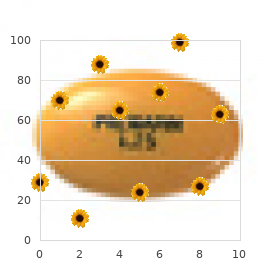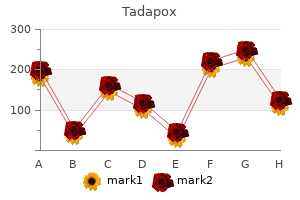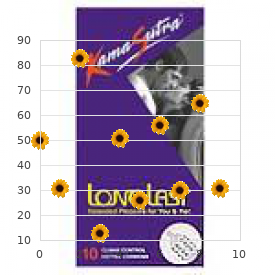Tadapox
"Buy generic tadapox canada, erectile dysfunction protocol by jason".
By: U. Rathgar, M.A., Ph.D.
Medical Instructor, University of Texas Medical Branch School of Medicine
In order to minimize the risk of fistula impotence urology generic tadapox 80 mg with visa, most commonly this procedure is performed after a hysterectomy and vaginectomy (or vaginal mucosal ablation) is performed impotence at 50 80mg tadapox with amex. A urethral hookup may be performed using cheek or vaginal mucosa erectile dysfunction treatment pdf purchase tadapox 80mg otc, and an erectile implant may be placed erectile dysfunction pill identifier discount 80 mg tadapox with amex. Often the entire phalloplasty procedure involves multiple staged surgeries, with earlier stages allowing skin grafts to develop local blood supply prior to cosmetic procedures to complete the phalloplasty. Depending on the surgical approach, the penis may or may not have intact erotic sensation. Risks associated with phalloplasty There are general risks associated with any surgery, including infection, bleeding, damage to surrounding tissues, and pain. Specific to phalloplasty in transgender men, there is risk of flap loss, urethral complications, wound breakdown, pelvic bleeding or pain, bladder or rectal injury, lack of sensation, prolonged need for drainage, or need for further procedures. Donor site risks include unsightly scarring, wound breakdown, granulation tissue formation, decreased mobility, hematoma, pain and decreased sensation. Different surgeons may also have different complications rates; understanding what procedures different surgeons perform, their experience, frequency with which they perform these procedures, and complication rates is helpful. June 17, 2016 147 Guidelines for the Primary and Gender-Affirming Care of Transgender and Gender Nonbinary People Immediate/early (within one month) complications after free or pedicled flap phalloplasty Wound infections typically occur within the first few weeks after surgery and can present as cellulitis, fungal infection or both. Wound breakdown is common and typically occurs at points where multiple suture lines meet. Most wound breakdown issues can be managed with local wound care (wet to dry dressing changes) as the wounds heal by secondary intention. Some wound breakdowns may require debridement(s), and fewer may require skin grafting or further surgical procedure(s) to close the wound. This is managed by making sure there are no kinks or twists in the tubing, flushing the catheter, and antispasmodic medications (anticholinergics). Flap loss is rare and typically occurs due to technical error (misplaced microsurgical suture or vascular pedicle kinking/compression). Flap loss typically presents within the first 72 hours, and if recognized early (within hours) can be salvaged by emergent return to the operating room. Hypercoagulable states can predispose a patient to clotting after surgery and flap loss. Pelvic or groin hematomas can occur, and may be managed by drains, or may require surgical drainage. While medical deep vein thrombosis prophylaxis with unfractionated heparin or lovenox may place the patient at higher risk of hematoma formation, this risk must be weighed against the risk of deep vein thrombosis and pulmonary emboli. Risk assessment models exist to help determine individualized perioperative anticoagulation modalities. The vaginectomy portion of the procedure involves developing a plane between the posterior wall of the vagina and the anterior wall of the rectum. Inadvertent injury to the rectal wall can present acutely (immediately known and repaired) or subacutely (days to June 17, 2016 148 Guidelines for the Primary and Gender-Affirming Care of Transgender and Gender Nonbinary People weeks later). Recognition of a rectal injury in the subacute period can be based on constitutional symptoms of fever, chills, malaise, or more overt symptoms of sepsis. The portion of the rectum in the surgical field is extraperitoneal, so abdominal pain or peritoneal signs would be unusual. Drainage of stool from the perineal incisions, scrotum or base of the phallus indicates formation of a fistula between the rectal wall and the skin. Such wounds require hospitalization and general surgical involvement in the care plan. A short-term colostomy may be required to divert the fecal stream and allow the fistula to close. Washout of a pelvic abscess and closure of the rectal fistula, with secondary wound healing may be required. Long-term complications after free or pedicled flap phalloplasty Urethral strictures typically present 6-12 months after surgery with symptoms of a weak stream, straining with urination, and sometimes concomitant fistulas secondary to distal obstruction from the stricture. Wound contraction and scarring are complications that occur any time the skin is cut, but the degree to which they occur is highly variable between patients. All scars contract with time as myofibroblasts within the wound become active in the first 2-9 days.



Always check the blood level after 12 days if a dose as high as this is used in a young baby erectile dysfunction zenerx order tadapox 80 mg overnight delivery. Blood levels Marrow toxicity can occur when the blood level exceeds 100 mg/l for any length of time erectile dysfunction medicine list buy discount tadapox 80mg on line, so it is advisable to check the serum level when the fourth dose is due if renal function could be impaired impotence vitamins discount tadapox 80 mg without prescription. Most large hospitals now have access to a laboratory that can measure this erectile dysfunction medication names buy generic tadapox 80 mg on-line, given at least 0. Peak levels occur a variable time after oral administration in young babies, so it is probably better to monitor the trough level, aiming for a level of 2540 mg/l (1 mg/l = 7. This can be infused (terminally) into a line containing glucose or glucose saline. Crystals of flucytosine may precipitate out if the temperature falls below 18 °C (these will be trapped by the 15 m filter if used). If precipitation is suspected, the bottle can be heated to 80 °C for 30 minutes to redissolve the precipitate, but decomposition (and 5-fluorouracil formation) occurs with sustained storage at temperatures over 25 °C. Evidence for conversion of 5-fluorocytosine to 5-fluorouracil in humans: possible factor in 5-fluorocytosine clinical toxicity. Flucytosine: a review of its pharmacology, clinical indications, pharmacokinetics, toxicity and drug interactions. Supplementation prior to conception can also reduce the risk of several fetal defects especially anencephaly or spina bifida. Several uncommon conditions, including primary and secondary cerebral folate deficiency and folinic acid-responsive seizures, result in progressive neurological deterioration. Peas, beans, green vegetables, yeast extract, Bovril and fortified cereals are all good dietary sources. Liver is a rich source of folate, but this should be avoided in pregnancy because of its high vitamin A content. Serum and red cell folate levels are higher in the newborn infant than the mother; deficiency is only seen if the mother is grossly deficient. Folate is actively excreted in breast milk and well absorbed in the duodenum and jejunum. Term formula milks contain 1113 micrograms/100 ml and preterm formula milks contain 3035 micrograms/100 ml. It is often claimed that folate requirements in infancy are as high as 2050 micrograms/day (410 times the adult requirement). Supplementary folic acid fails to produce any rise in haemoglobin in the absence of megaloblastic anaemia, even in babies with severe haemolytic disease. Many units still offer a routine supplement of 50 micrograms/day to every preterm baby, but there is no evidence that this is necessary. In countries that have not adopted a policy of food supplementation, women should take 400 micrograms once a day before conception and for the first 12 weeks of pregnancy to minimise the risk of neural tube defects. The addition of pyridoxine has been suggested together with a lysinerestricted diet. Megaloblastic anaemia: In the absence of vitamin B12 deficiency, infants are usually treated with 1 mg of folic acid daily by mouth. If this is due to dietary deficiency rather than malabsorption or disorders of folate metabolism, then they should respond rapidly to physiological doses of folic acid (50 micrograms/day). Symptoms develop insidiously during the first months of life, and deficiency can have permanent consequences unless the diagnosis is made before growth has already been affected. Maternal prophylaxis Treating folate deficiency diseases in infancy Supply Folic acid: 150 ml of a 50 micrograms/ml sugar-free oral suspension costs Ј9. For maternal use, 400 micrograms tablets (which need no prescription) and 5 mg tablets cost approximately 2p each. Levofolinic acid, the levo-isomer of folinic acid, is also available but is considerably more expensive (175 mg vials cost Ј85). Incidence of neural tube defects in the least-developed area of India: a population-based study. Specialised infant formula milks with modified protein, carbohydrate or fat content are available to treat a range of conditions. Lactose intolerance Lactose intolerance may be congenital, primary (including congenital) or secondary.

These symptoms may be even greater in transgender men for whom examination of genital and reproductive organs may be particularly challenging and triggering of June 17 vascular erectile dysfunction treatment cheap 80mg tadapox mastercard, 2016 62 Guidelines for the Primary and Gender-Affirming Care of Transgender and Gender Nonbinary People gender dysphoria xenadrine erectile dysfunction buy tadapox 80mg, and result in avoidance of pelvic exams erectile dysfunction by race buy tadapox. Role of hysterectomy In addition to non-surgical approaches erectile dysfunction for young adults tadapox 80mg for sale, in some cases hysterectomy may have a role in the management of pelvic pain. Depending on the preferences and reproductive goals of an individual patient, gynecologists may revise their therapeutic approach to consider hysterectomy earlier than they might in non-transgender women (Grading: X C S). At the same time hysterectomy should not be viewed as a cure-all, and in some cases is not effective in improving pain. For this reason, transgender men with pelvic pain must be evaluated on a case-bycase basis due to the lack of evidence-based guidance at this time. Decision to perform oophorectomy should be based on the etiology of pelvic pain, presence of comorbidities, future fertility desires, and any future plans to stop taking testosterone. Management of specific symptoms and syndromes If pain is vulvar and there are no identifiable lesions or infections, Consider the use of topical 2-5% topical lidocaine placed on soaked cotton-ball and left in the vestibule overnight for general pain relief, or for 30 minutes prior to sexual activity as desired. If pain is vulvar and exam is consistent with vaginal atrophy in the setting of testosterone administration, consider a short course of vaginal estrogen in doses and administration similar to that used for post-menopausal non-transgender women. Patients who are uncomfortable with intravaginal use may be instructed to place treatment cream on their external genitalia. Choice between tablets, creams, and rings depends on patient preference and formulary considerations. If pain is abdominal, present in the abdominal wall or associated with abdominal scar tissue, consider treatment with 1% lidocaine instilled at trigger points in repeated administration. If transvaginal ultrasound is required, consider a low-dose benzodiazepine such as lorazepam 0. Some patients may feel safer and more comfortable placing the ultrasound probe intra-vaginally themselves. June 17, 2016 63 Guidelines for the Primary and Gender-Affirming Care of Transgender and Gender Nonbinary People Introduction: Persistent menses & unexpected vaginal bleeding Many transgender men chose not to undergo hysterectomy, oopherectomy and/or gender-affirming genital procedures. For those transgender men using physiologic doses of testosterone, cessation of menses is expected, typically within 6 months. Cessation of menses is driven by a combination of testosterone induced ovulation suppression, which may be incomplete, and endometrial atrophy. Factors that affect time to cessation of menses likely include: dose of testosterone, route of administration, frequency of testosterone administration, presence and functioning of ovaries, body habitus, and the presence of other structural or nonstructural medical conditions of the uterus or ovaries. Transgender men with a history of abnormal cycles prior to initiating testosterone. Therefore in patients with risk factors for endometrial hyperplasia and a degree of clinical suspicion, evaluation for and elimination of known causes of irregular bleeding should be considered concurrent with testosterone administration; those with pre-existing amenorrhea or oligomenorrhea may require evaluation for endometrial abnormalities prior to initiating testosterone. This includes ruling out pregnancy in transmen who are sexually active with partners who produce sperm. Despite prior suggestions that endometrial cancer risk may be increased in transgender men on testosterone,[25] longer-term data do not support this risk. Both structural and non-structural causes should be investigated in consultation with a gynecologist. The decision to pursue transvaginal ultrasonography or endometrial biopsy should not be taken lightly in transgender men who may find these procedures invasive. Noninvasive diagnostic approaches such as watchful waiting for induction of amenorrhea 6 months after initiation of testosterone, observing for a withdrawal bleed after a progestin challenge, or use of a transabdominal approach to ultrasonography should all be considered. Persistent menses despite testosterone may also be related to body habitus; those with higher June 17, 2016 64 Guidelines for the Primary and Gender-Affirming Care of Transgender and Gender Nonbinary People levels of body adipose tissue have higher endogenous estrogen levels and increased conversion of testosterone to estradiol through the peripheral aromatization process. Therapeutic approaches based on etiology Increasing the dosage and frequency of dosing (1 and 2 weeks) of intramuscular testosterone has been found to be positively correlated with rapidity of amenorrhea induction. For example, one study of transgender men presenting for initiation of crosssex hormones found that 84% of those completing the study were amenorrheic at 6 months. This was despite many only 58% achieving physiologic male total testosterone levels and 68% achieving physiologic male free testosterone levels. Endometrial ablation can be considered [31] for those transgender men who do not desire future fertility and who also either decline hysterectomy or have surgical complications. Aromatase is expressed throughout the body including the ovaries, endometrium, skin, bone, breast, brain and adipose tissue. Weight loss plays a critical role in all cases for health promotion as well as resulting in amenorrhea through reduction of adipose containing aromatase.

Syndromes
- Recently placed artificial joints
- Fainting or feeling light-headed
- Tenderness, swelling, or redness at the site of the tumor
- Diabetes
- Pulmonary function tests
- Delirium
- CIN I is mild
- Shoulder pain
- Diabetes
- Pituitary gland dysfunction (rare)

Kawasaki disease Kawasaki disease impotence for erectile dysfunction causes generic tadapox 80mg line, first described in 1967 purchase erectile dysfunction drugs buy tadapox with a visa, is a systemic vasculitis predominantly affecting children under the age of 5 years (peak incidence at 911 months) what causes erectile dysfunction in males buy 80mg tadapox otc. Features include high fever for at least 5 days with a variable rash erectile dysfunction kidney transplant order tadapox on line amex, conjunctivitis, inflamed oral mucosa, swollen neck glands and redness and swelling of the hands and feet with later desquamation. Other common features include abdominal pain, vomiting, diarrhoea, aseptic meningitis, arthritis and mild liver dysfunction. The exact aetiology has not yet been established, but there is considerable support for it to be due to an infectious agent. Mild cases may go unrecognised, but nearly a third of children with overt disease develop serious inflammation of the coronary arteries, sometimes leading to aneurysm formation, if treatment is not started early. A high platelet count during convalescence further increases the risk of coronary thrombosis and myocardial infarction. There is no clear evidence that high doses (80100 mg/kg/day) are better than low doses. Patients with severe or progressive vasculitis should be referred promptly to a paediatric cardiologist. If there is no evidence of coronary lesions after 8 weeks, it may be discontinued; if coronary artery lesions persist, then the child should remain on treatment. Thrombus prophylaxis: A dose of 15 mg/kg is used after Fontan and BlalockTaussig shunt surgery and is also often given for 3 months after certain other forms of cardiac surgery to minimise the risk of clot formation until endothelial lining cells finally cover all post-operative scar tissue. Treatment Monitoring Oral absorption can be variable during the acute inflammatory phase of Kawasaki disease. Monitoring salicylate levels is not usually required unless the child is receiving high doses. To obtain a 5 mg/ml sugar-free solution for oral use, add one 75 mg tablet of dispersible aspirin to 15 ml of water, and use immediately. Antiplatelet agents for prevention of pre-eclampsia: a metaanalysis of individual patient data. Antiphospholipid syndrome in pregnancy: a randomised, controlled trial of treatment. Aspirin consumption during the first trimester of pregnancy and congenital anomalies: a meta-analysis. Exposure to non-steroidal anti-inflammatory drugs during pregnancy and risk of miscarriage: population based cohort study. Clinical outcomes of palliative surgery including a systematic-to-pulmonary artery shunt in infants with cyanotic congenital heart disease. Early administration of low-dose aspirin for the prevention of severe and mild preeclampsia: a systematic review and meta-analysis. It is one of a number of drugs that are used for this purpose; other agents include betamimetics (such as ritodrine), magnesium sulphate, prostaglandin inhibitors. Oxytocin, secreted by the pituitary in a pulsatile manner, is also produced by the ovaries, the placenta, the fetal membranes and the myometrium and has long been recognised to have an important role in the initiation of labour. Binding of oxytocin to receptors on uterine muscle is thought to initiate uterine contractility by increasing the myometrial intracellular calcium. Oxytocin further stimulates uterine contractility and initiates cervical ripening by stimulating the release of prostaglandins in the decidual and fetal membranes. Atosiban was introduced into use in 1998 and can inhibit labour at least as effectively as any betamimetic. It can sometimes cause nausea and headache but seldom causes the tachycardia or the other unpleasant maternal side effects associated with betamimetics. Despite its low molecular weight, relatively little seems to cross the placenta, and there is no reason to think that its appearance in breast milk is of any clinical significance. Pharmacology Choice of tocolytic agent the choice of tocolytic agent is not straightforward; the ideal agent should delay delivery by 48 hours, reduce neonatal mortality and neonatal respiratory distress syndrome and have few maternal side effects. Two randomised comparisons involving 207 women given either atosiban or nifedipine (q.
Best buy tadapox. Permanently Cure Erectile Dysfunction | Explained in Hindi | Dr.Education.

